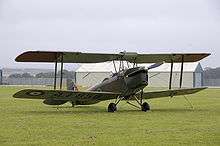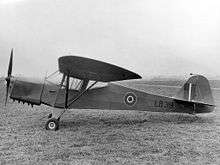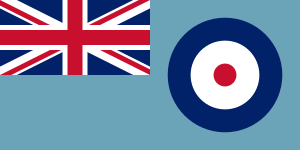No. 654 Squadron RAF
No. 654 Squadron RAF was a unit of the Royal Air Force during the Second World War. Numbers 651 to 663 Squadrons of the RAF were Air Observation Post units working closely with Army units in artillery spotting and liaison. A further three of these squadrons, 664-666, were manned with Canadian personnel. Their duties and squadron numbers were transferred to the Army with the formation of the Army Air Corps on 1 September 1957.[3][4]
| No. 654 Squadron RAF | |
|---|---|
| Active | 15 July 1942 – 24 June 1947 |
| Country | |
| Branch | |
| Role | Air Observation Post Squadron |
| Motto(s) | Progressive[1] |
| Insignia | |
| Squadron badge heraldry | A propellor and gun barrel in saltire[1] |
| Squadron codes | QA (1944 - May 1945, HQ Flight)[2] QB (1944 - May 1945, 'A' Flight)[2] QC (1944 - May 1945, 'B' Flight)[2] QD (1944 - May 1945, 'C' Flight)[2] |
| Aircraft flown | |
| Reconnaissance | de Havilland Tiger Moth Taylorcraft Auster |
History

No. 654 Squadron was formed at RAF Old Sarum, Wiltshire, on 15 July 1942 and went into action on August 1943 in North Africa. From December 1943, it served in Italy, where it remained until disbanding at Campoformido on 24 June 1947.
No. 1906 Air Observation Post Flight was formed within 654 Squadron previously elements of 'A' & 'B' Flights along with No. 1907 Air Observation Post Flight which was formed within 654 Squadron previously elements of 'A' & 'C' Flights.[5]
Present
The original squadron was represented by 654 Squadron of 4 Regiment, Army Air Corps. 654 AAC disbanded in July 2014, as part of Army 2020.[6]
Aircraft operated

| From | To | Aircraft | Variant |
|---|---|---|---|
| July 1942 | September 1942 | de Havilland Tiger Moth | Mk.II |
| September 1942 | December 1942 | Auster | Mk.I |
| December 1942 | October 1944 | Auster | Mk.III |
| June 1944 | June 1947 | Auster | Mk.IV |
| December 1944 | June 1947 | Auster | Mk.V |
References
Notes
- Halley 1988, p. 446.
- Flintham and Thomas 2003, p. 98.
- Halley 1988, p. 444.
- Jefford 2001, pp. 102–105.
- Lake 1999, p. 100.
- "Archived copy". Archived from the original on 6 March 2016. Retrieved 8 July 2014.CS1 maint: archived copy as title (link)
- Jefford 2001, p. 103.
Bibliography
- Flintham, Vic and Andrew Thomas. Combat Codes: A full explanation and listing of British, Commonwealth and Allied air force unit codes since 1938. Shrewsbury, Shropshire, UK: Airlife Publishing Ltd., 2003. ISBN 1-84037-281-8.
- Halley, James J. (1988), The Squadrons of the Royal Air Force & Commonwealth, 1918-1988, Tonbridge, Kent, UK: Air-Britain (Historians) Ltd., ISBN 0-85130-164-9
- Jefford, C.G. (2001), RAF Squadrons: A Comprehensive Record of the Movement and Equipment of all RAF Squadrons and their Antecedents since 1912, Shrewsbury, Shropshire, UK: Airlife Publishing Ltd., ISBN 1-84037-141-2
- Lake, A (1999). Flying units of the RAF. Shrewsbury: Airlife. ISBN 1-84037-086-6.
External links
